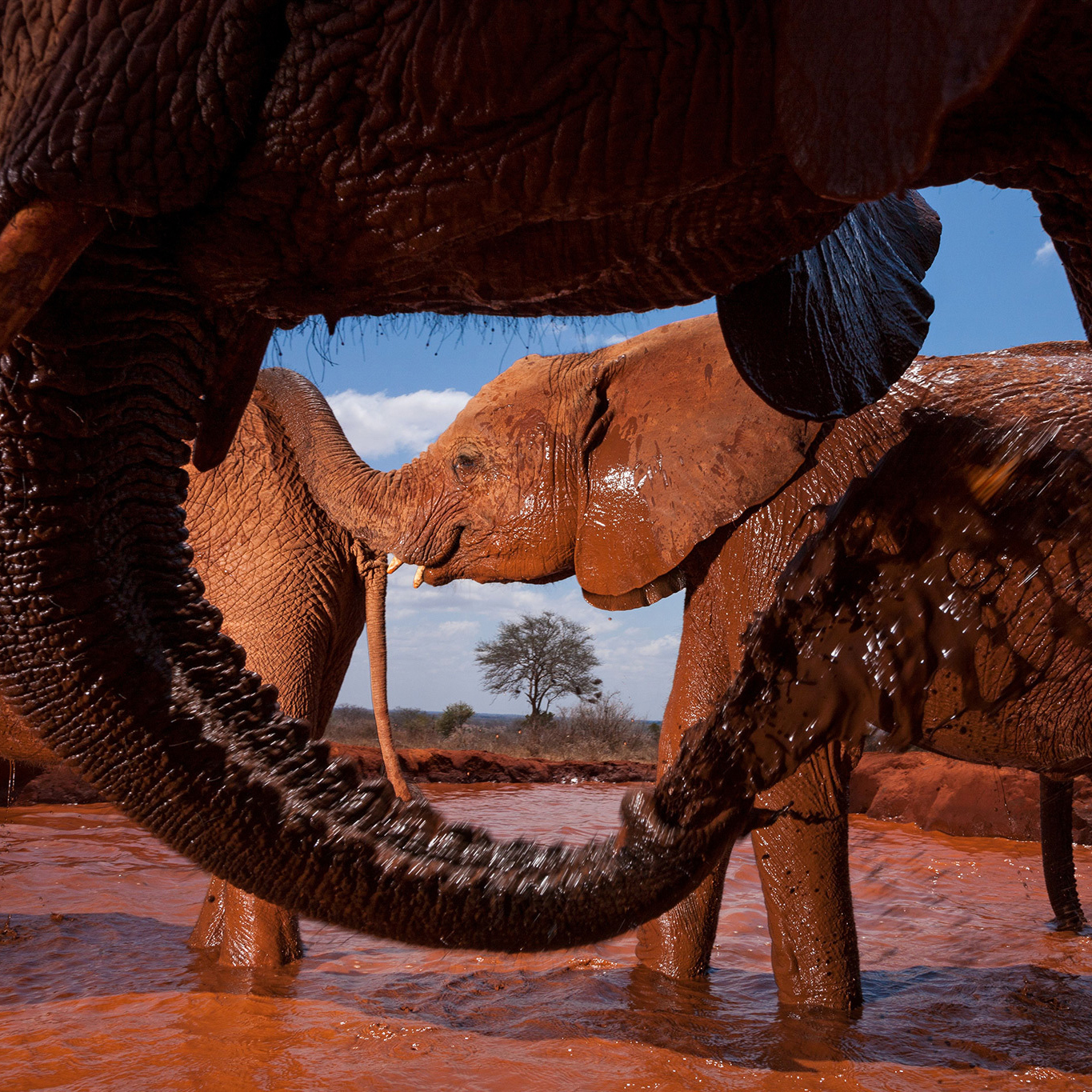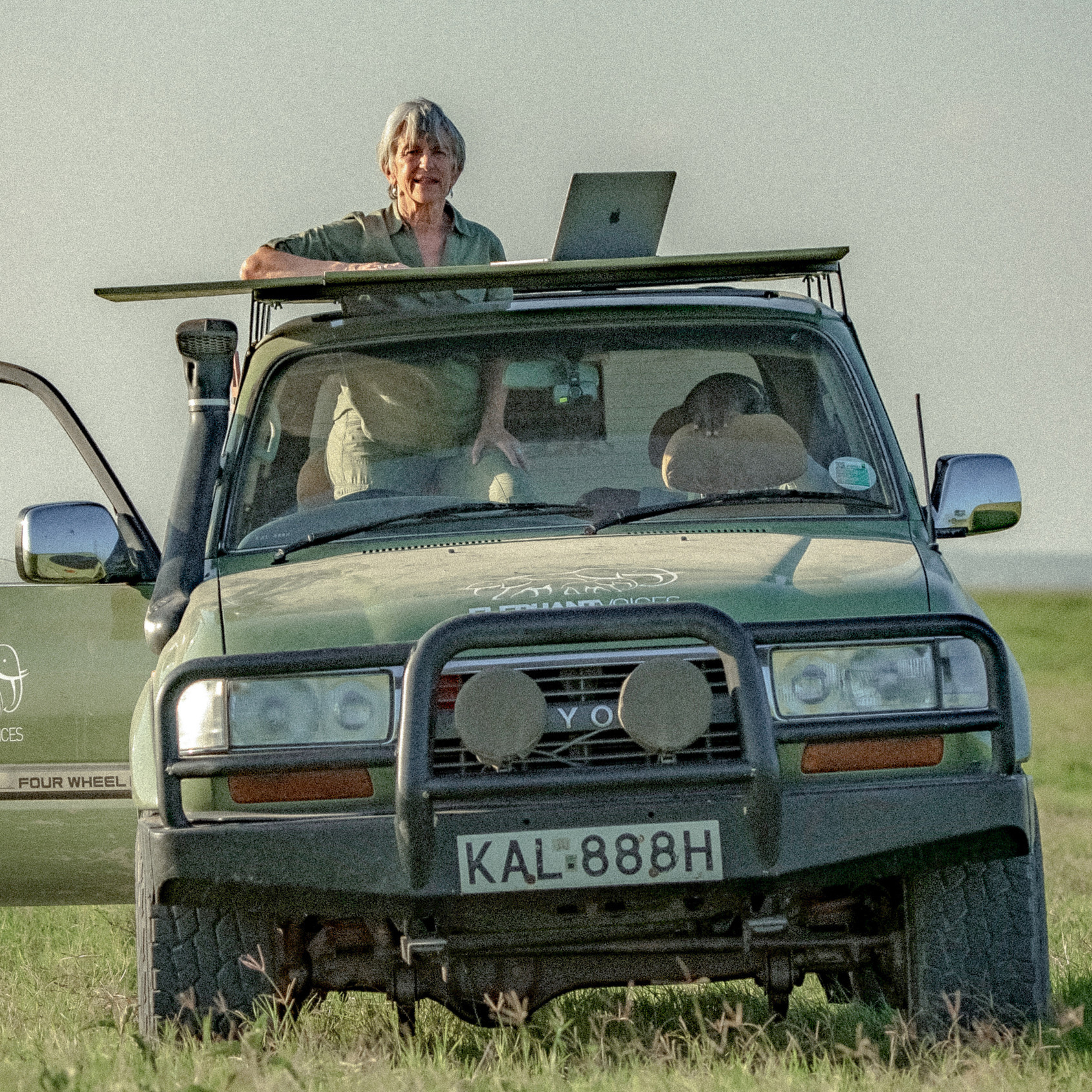

Asia
ASIA
Nepal
MyanMAR
India
Bangl.
Laos
ThaiLAND
Camb.
SRI
LANKA
Malaysia
Borneo
Sumatra
Asian elephant
Elephas maximus
Indonesia

Asia
ASIA
Nepal
MyanMAR
India
Bangl.
Laos
ThaiLAND
Camb.
SRI
LANKA
Malaysia
Sumatra
Borneo
Indonesia
Asian elephant
Elephas maximus

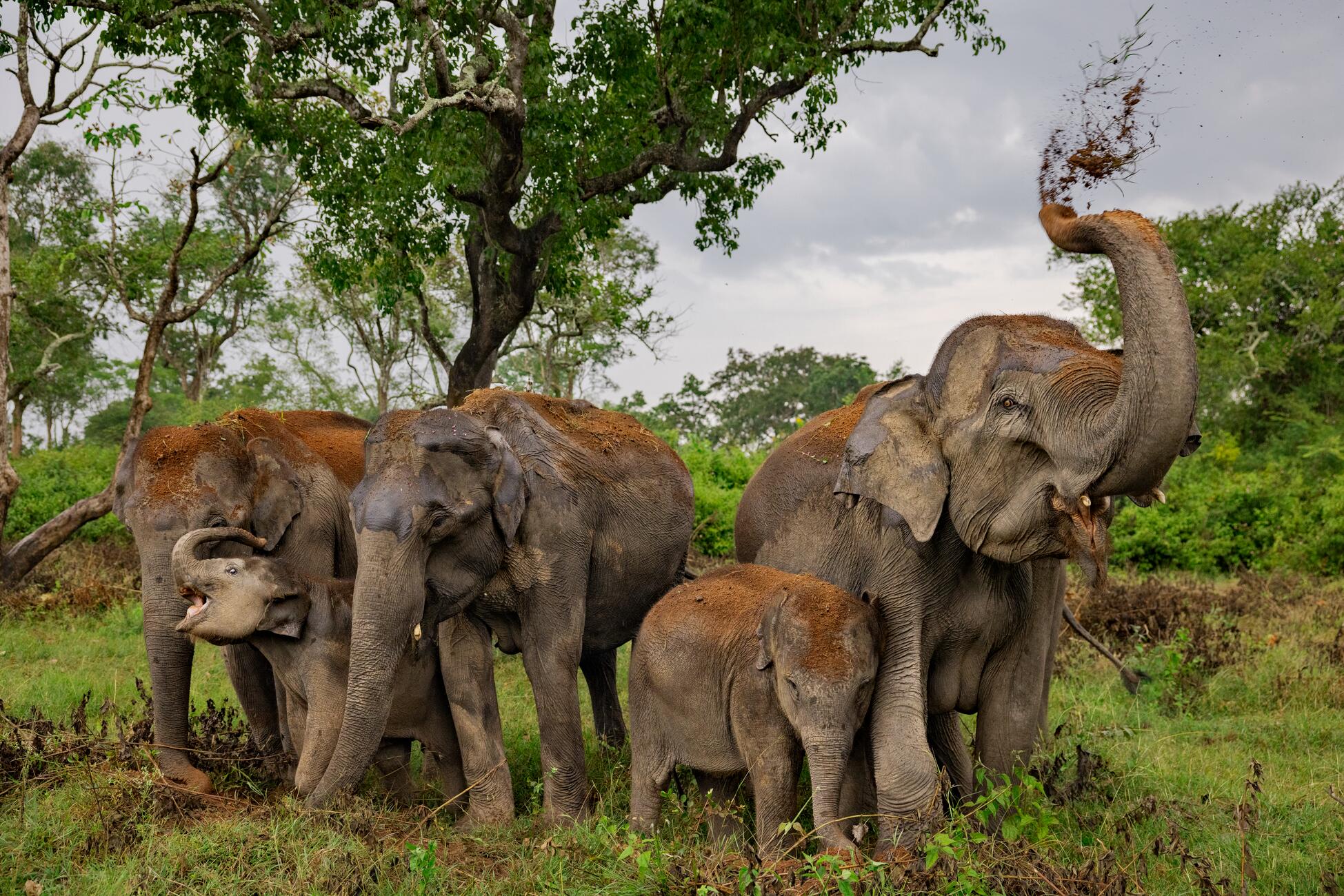
Young elephants in India’s Bandipur National Park throw dirt on themselves. This is a behavior they observed from their mothers to protect their skin from sun and insects.
There’s an emerging consensus that Asian elephants are highly intelligent, on par with species such as dolphins and chimpanzees. For instance, some have shown an awareness of their own body and mirror reflections, an exceedingly rare skill in the animal kingdom.
Not only that, they’re also very flexible, navigating a variety of habitats, from open grasslands to agricultural fields to tea plantations heavily used by people.
(Learn more about elephants’ “superpowers” in this animated video.)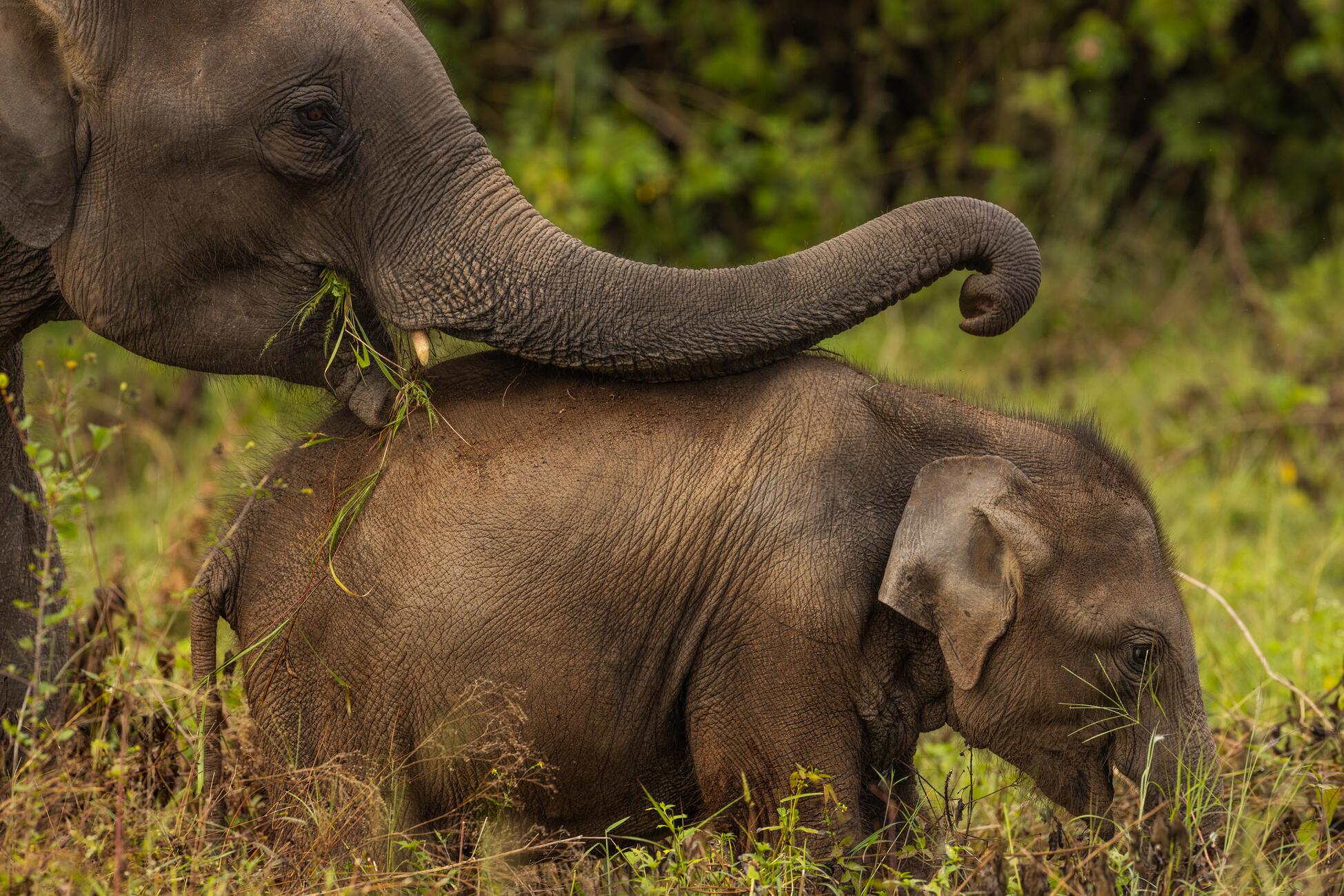
Born at around 200 pounds, calves (such as this one in India’s Bandipur National Park) rely on their mother’s milk for three years. Females remain with their herd for life, while males strike out on their own when they reach puberty.
LISTEN
BEHIND THE PHOTO
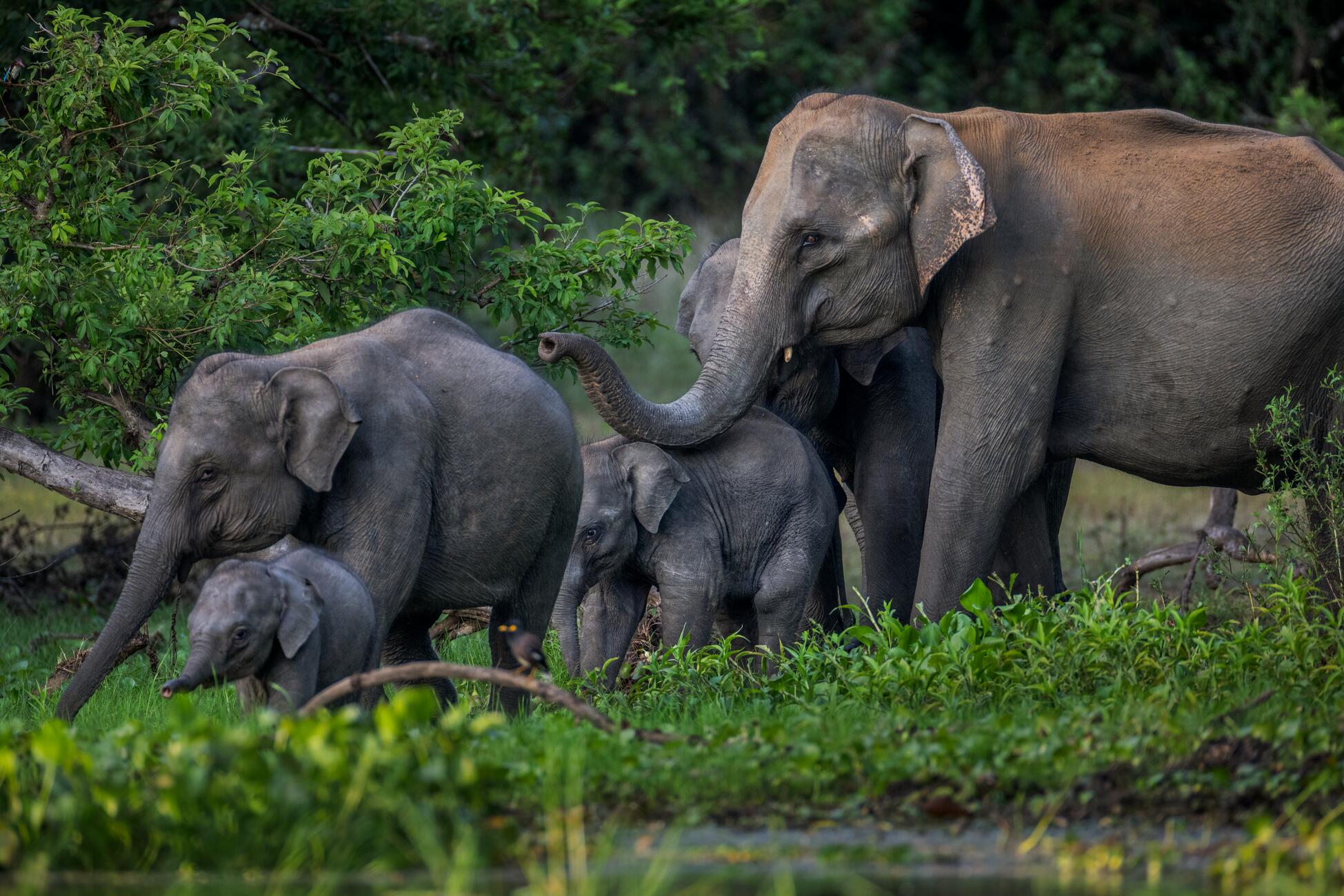
Near the Kahalla-Pallekele nature reserve in Sri Lanka, a female elephant touches a calf with her trunk while leading a group of young to water. Elephants take years to mature, all while observing adult behavior. Some juveniles help care for younger calves.
For a long time, scientists assumed Asian elephants had social structures similar to those of African savanna elephants. This was certainly true on the surface: Both long-lived species gather in herds of related adult females and calves, with males leaving the group during adolescence, when they’re eight to 13 years old.
But a key aspect of African savanna elephant society—that the oldest female, the matriarch, is the most dominant—doesn’t appear with Asian elephants. Instead, these pachyderms live in smaller, less hierarchical, and more loosely collected groups that can separate and reunite over time—a fluidity that allows them to adapt to rapidly changing resources.
(Explore more traits of African and Asian elephants in this interactive graphic.)They’re also persistent in finding food, as illustrated by the preliminary results of a study in Thailand, in which more than half of wild elephants tested could use their trunks to open at least one door of a complex puzzle box to get fruit inside. Finding out more about how elephant minds work may help people learn how to live alongside their multi-ton neighbors, experts say.
(See how National Geographic has covered elephants for more than 100 years.)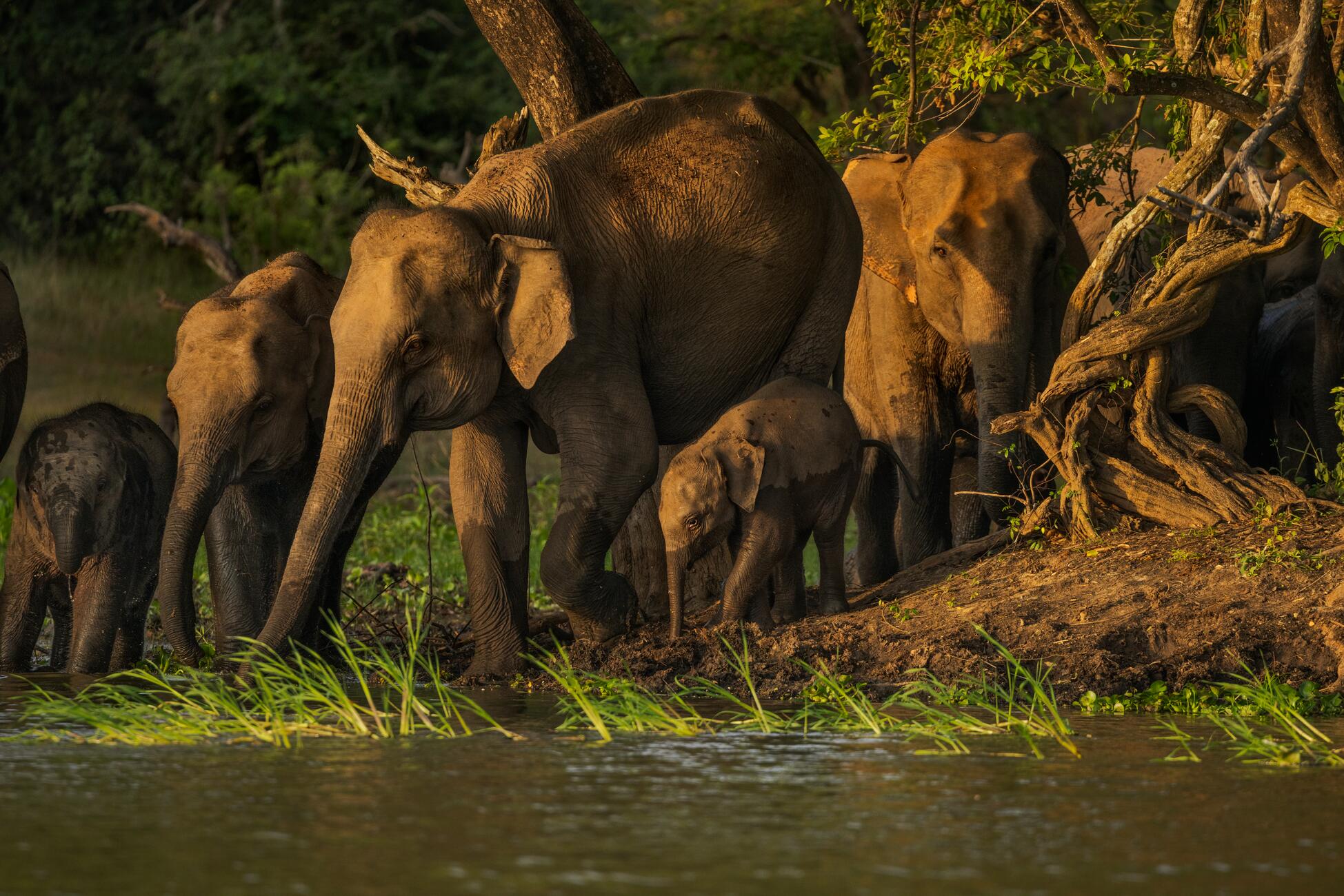
Elephants drink from a lake near Galgamuwa, in northwestern Sri Lanka. With much of the country’s land developed, its estimated 6,000 elephants are forced to share almost 70 percent of their habitat with humans.
LISTEN
BEHIND THE PHOTO

Sumith Ranatunga, 44, was lucky to survive after being knocked off his motorcycle and trampled by an elephant in Galgamuwa in 2022. Still, he bears no ill will toward the animals, saying, “If we could return the forests to the way they were, we would not have this problem. It is we who have taken from the elephants.”
With possibly only about 50,000 wild Asian elephants left, including 30,000 in India, researchers and conservationists agree that if the species is to survive, people and elephants need to get along. And there’s still a long way to go.
From 2020 to 2022, people in Sri Lanka killed more than 1,100 elephants, and nearly 400 people died in elephant encounters. In India, from 2018 to 2020, 300 elephants and 1,400 people died because of human-elephant conflict, a phenomenon that occurs when habitat loss forces both species into close contact, often leading to injuries or death.
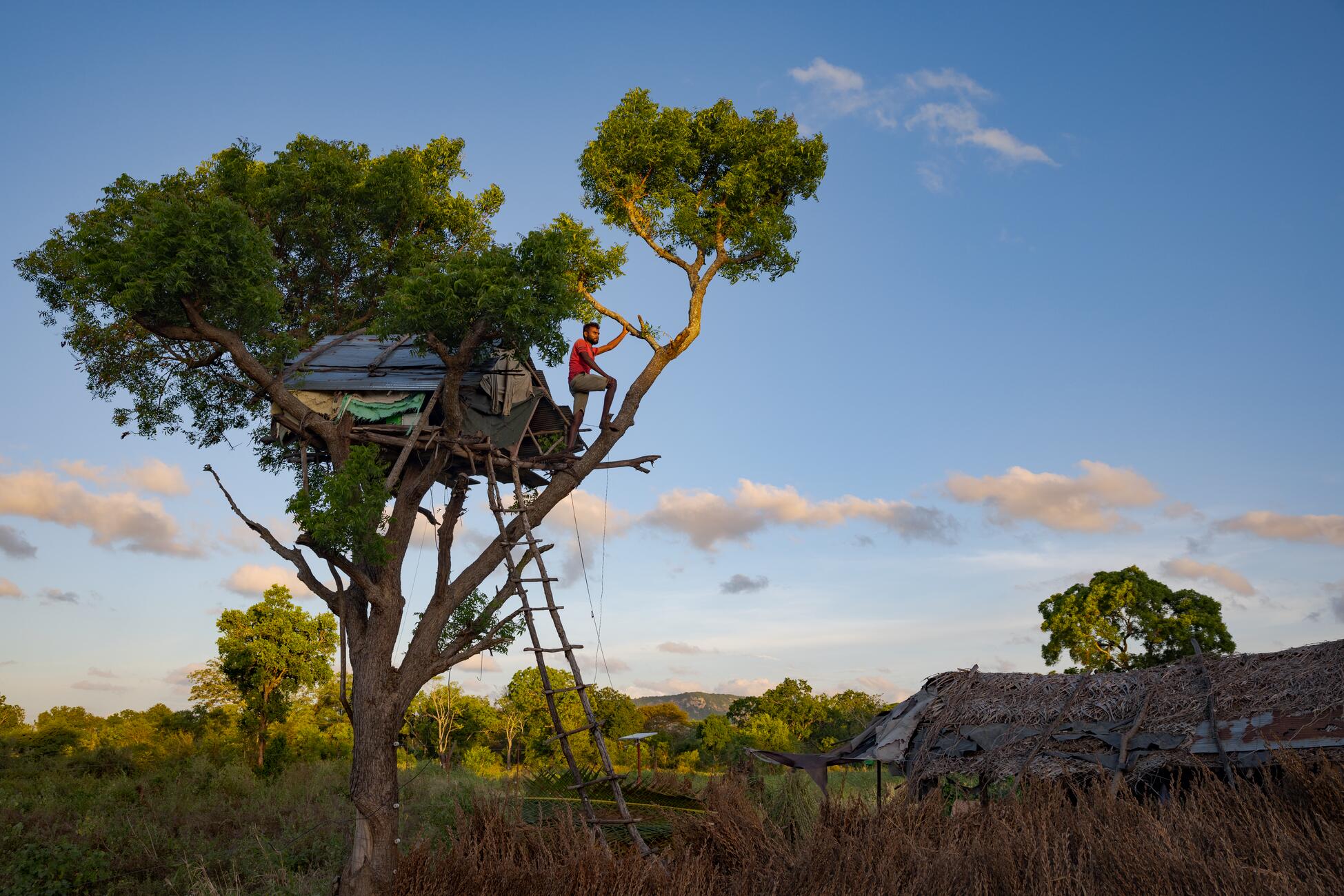
Upul Chataranga, 28, spends many nights a year in a lookout, guarding crops from elephants near Galgamuwa, Sri Lanka. When the animals approach, he begins shouting and lighting firecrackers, but this can make the animals more aggressive.
LISTEN
BEHIND THE PHOTO
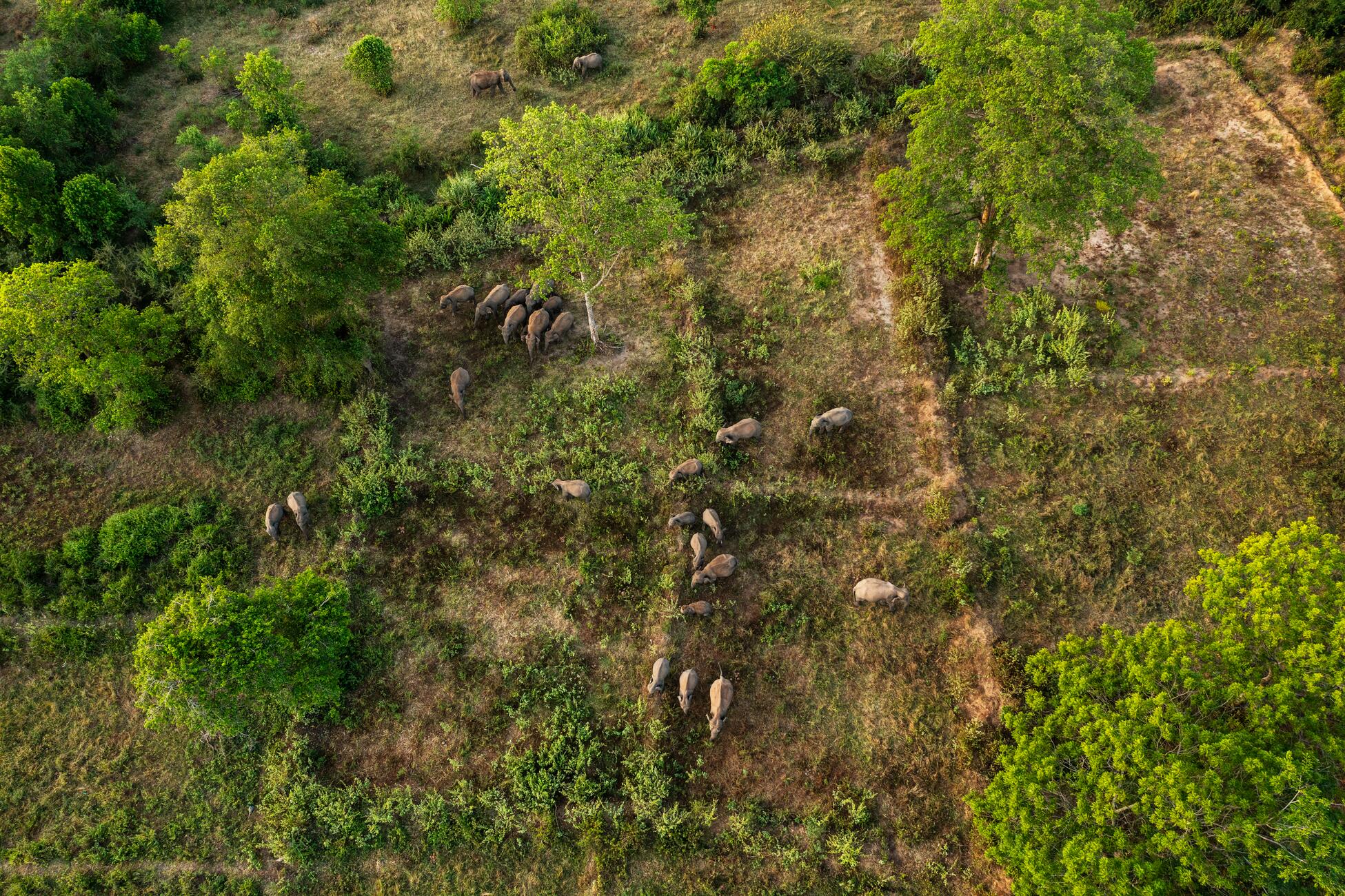
A herd of dozens of wild elephants roams rice fields near the Kahalla-Pallekele nature reserve. Fallow fields ease human-elephant coexistence by allowing elephants to move from one place to another without prompting flare-ups with people.
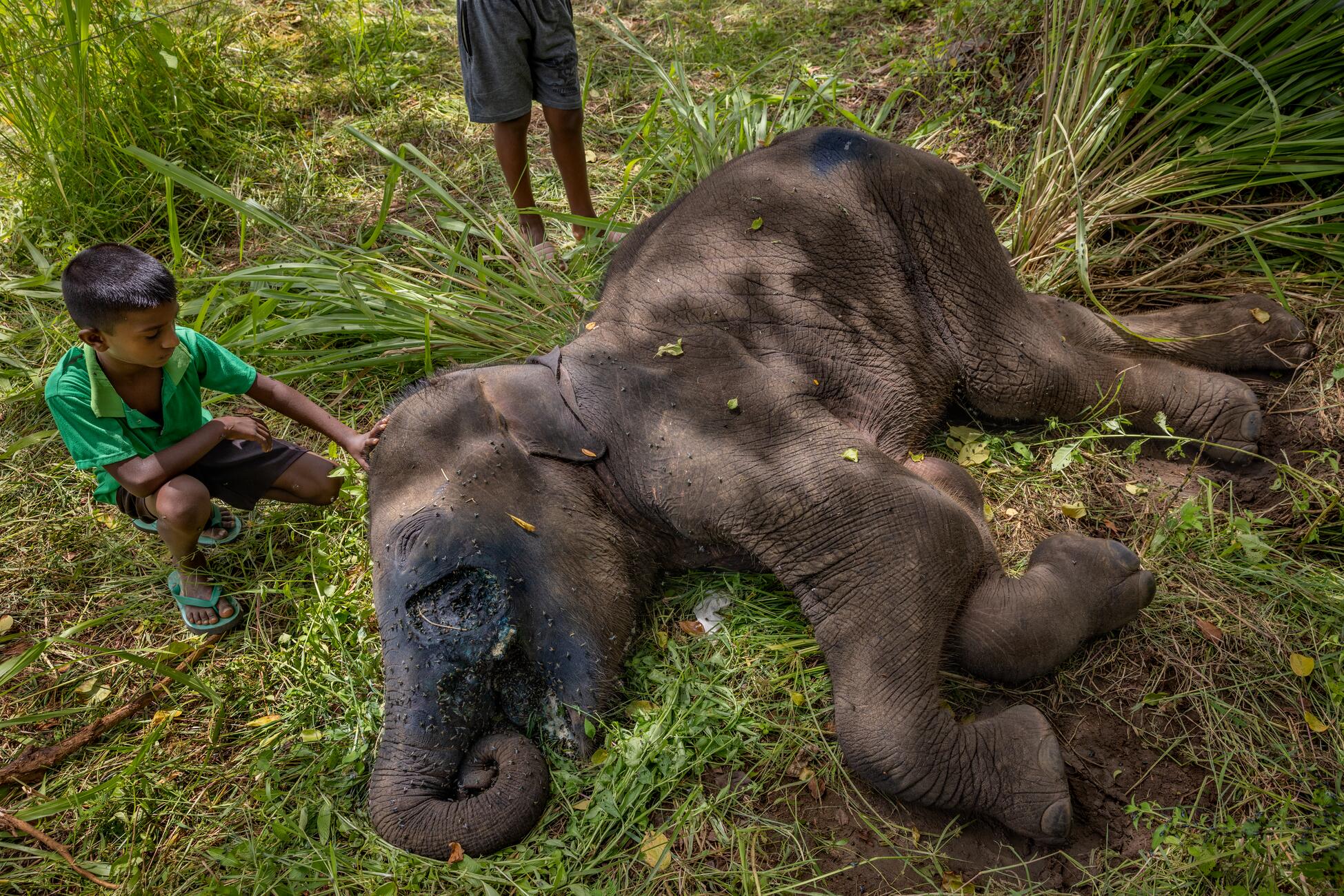
A boy in Galgamuwa gently touches a young elephant killed by a hakka pata, or “jaw bomb”—an improvised explosive concealed in edible bait. Hunters and farmers set these weapons to kill smaller animals for food, such as boars, but elephants often become victims, unable to eat and dying slowly of starvation.
Confrontational methods to deter elephants, such as using firecrackers or guns, are ineffective, and can both harm elephants and make them more aggressive, scientists find.
The only thing that works, experts say, is the electric fence. The often solar-powered structure for keeping elephants away from villages, gardens, or croplands delivers a gentle jolt to an animal that attempts to cross it. Yet in an arms race of sorts, the elephants are constantly testing their boundaries: using their trunks to investigate electrified wires or pushing trees onto fences and then stepping between the fallen wires.
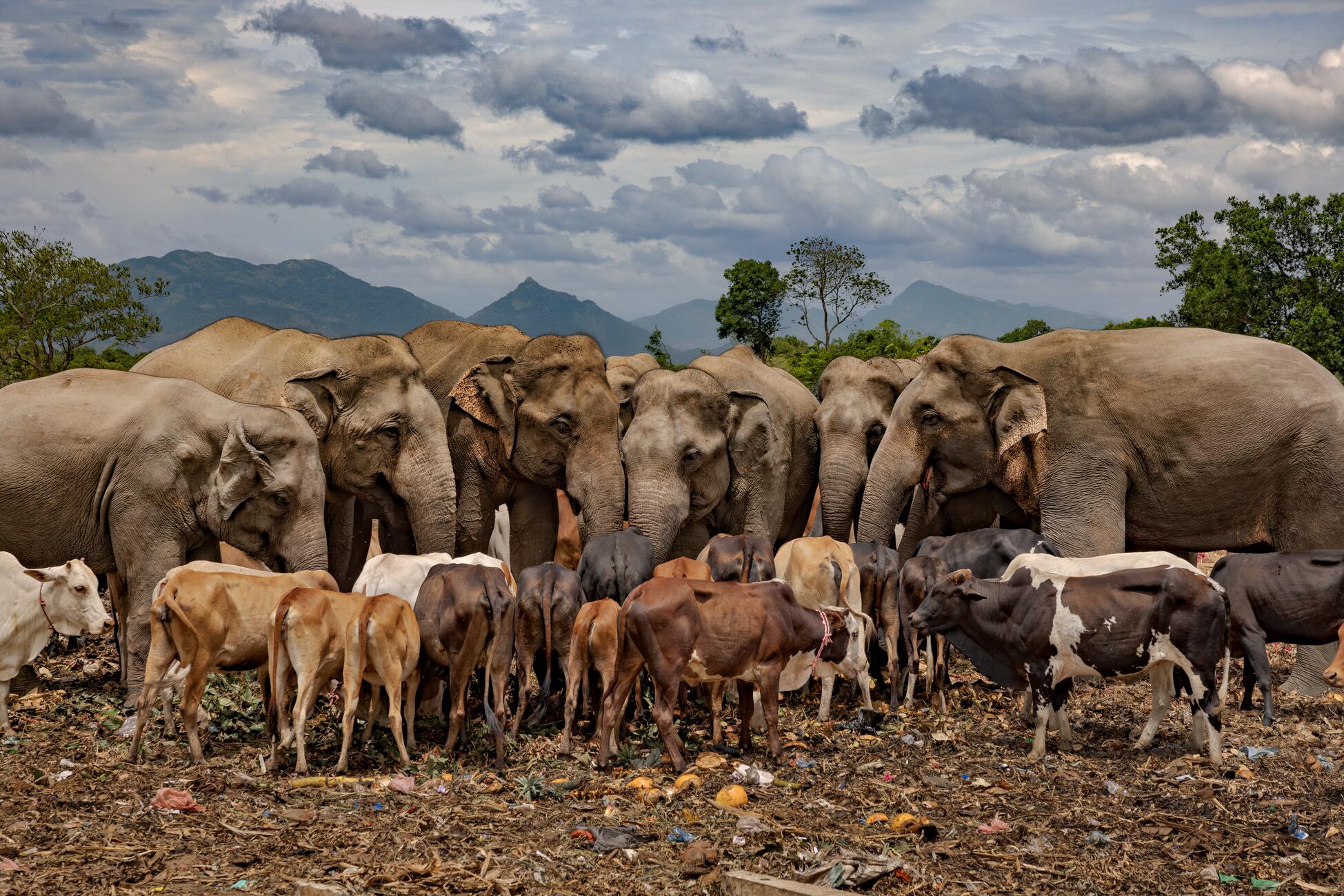
A group of male elephants feeds at a dump near Dambulla, Sri Lanka. The animals are drawn to nutrient-rich organic waste from the town’s markets. Many elephants, alerted by the sounds of vehicles, arrive at dumps just as garbage is being unloaded.

D.M. Premathilaka, 69, stands outside his ruined house in Kithuluthuwa village, in Sri Lanka. A large bull elephant looking for food knocked down a wall before being chased away by firecrackers. Sri Lanka’s wildlife authority compensates homeowners for damage caused by elephants, but it takes time and payment can be a little less than the cost of repairs.
Another solution is the early-warning system, in which the approach of an elephant sets off a bevy of warnings, from red beacons to text messages to voice calls, to notify locals to get inside until the animals have passed. This system has completely eliminated human deaths from elephant encounters for the past two years in Valparai, a region of tea plantations in southern India.
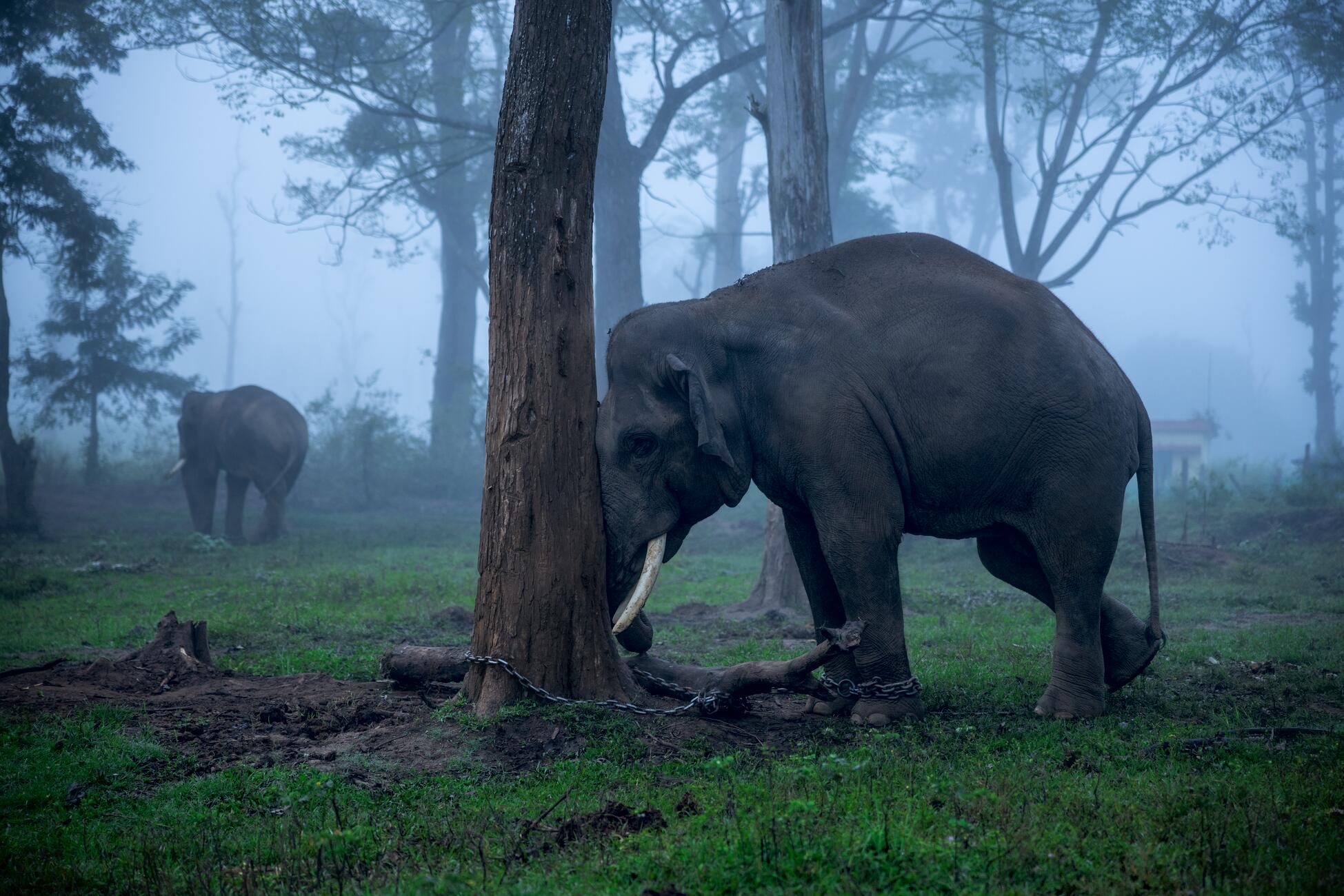
A chained elephant leans against a tree to take weight off his legs at the Dubare Elephant Camp, in India. A popular tourist attraction, this government-run camp is for elephants used in logging or wild elephants that have been orphaned or have had repeated run-ins with humans.
LISTEN
BEHIND THE PHOTO
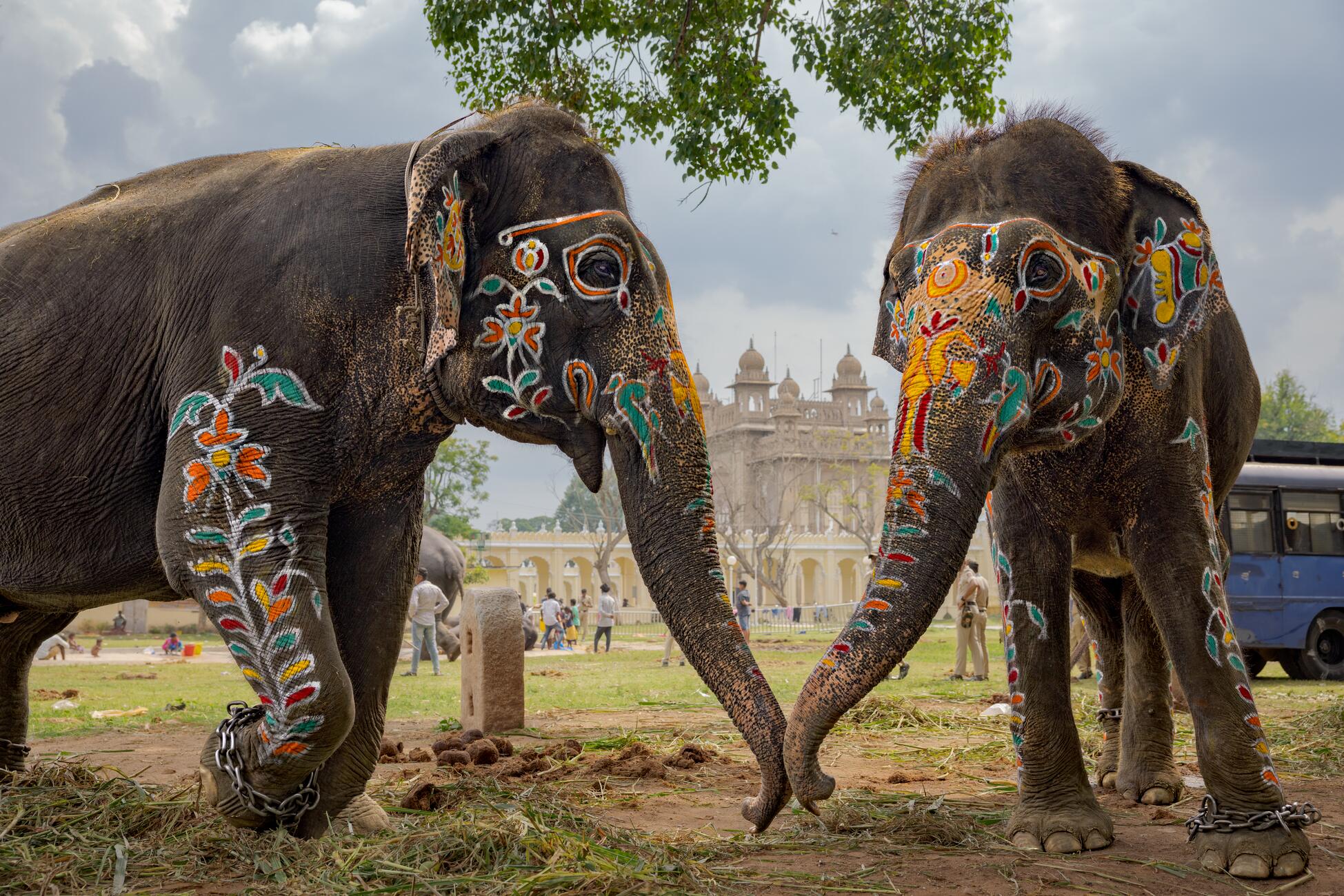
At Mysuru Palace in India, elephants touch trunks, perhaps a gesture of comfort. Festivals can be stressful for the pachyderms; the day before, these animals were among large crowds of people at the Dasara celebration.
People and elephants in Asia have a long, intertwined history. Seals from the Harappa civilization, over 4,000 years old, depict tamed elephants. With the advent of kingdoms and republics in India in the first millennium B.C., the elephant became prominent as an animal of war—used as a fighting platform and to charge enemy ranks—and remained so until a few hundred years ago.
After they stopped being used for war, the animals continued to be mainstays for activities such as transporting goods and logging.
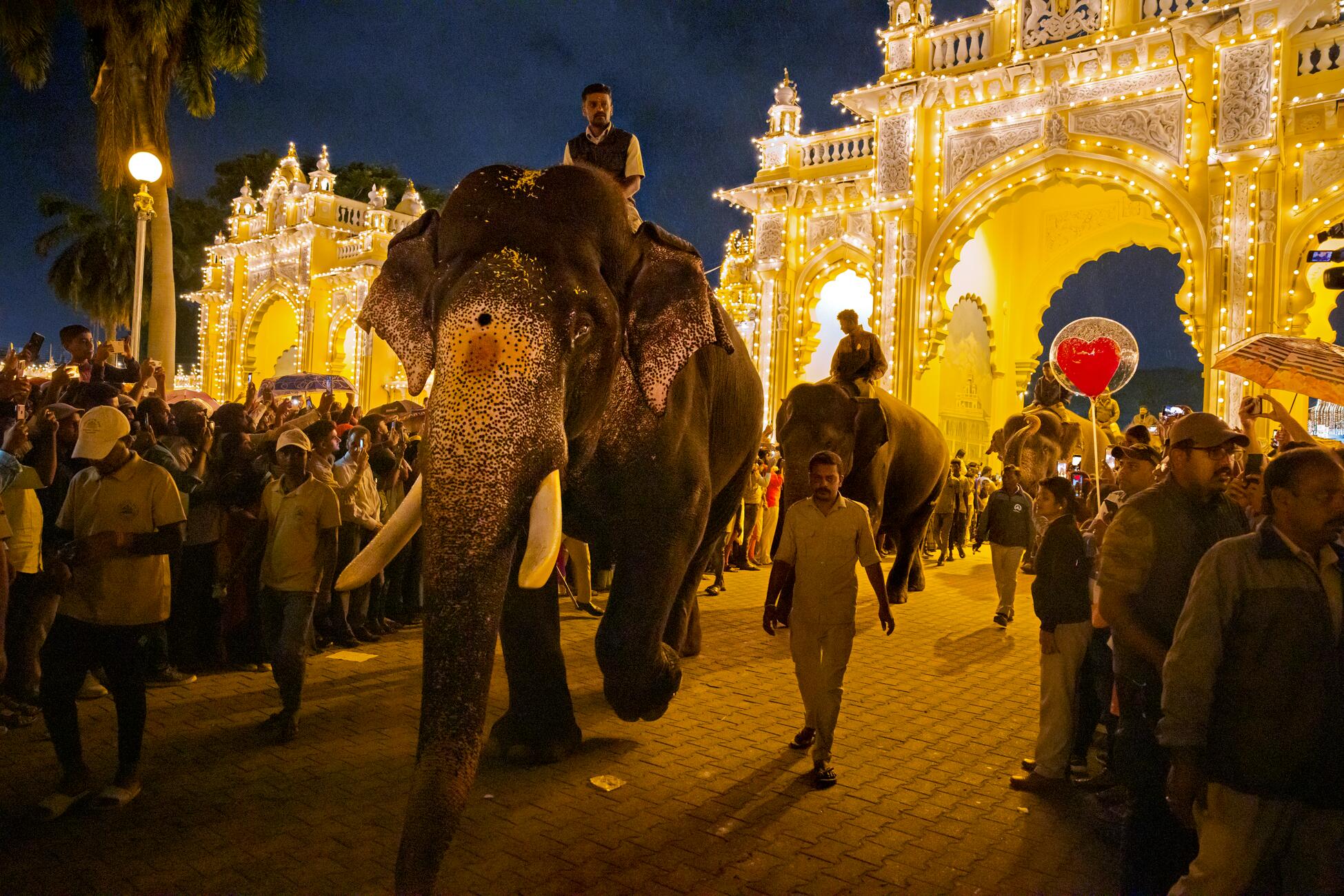
Beloved religious symbols in many Asian cultures, elephants are the highlight of the annual Dasara festival procession in Mysuru. They’re also icons of power long associated with royalty and known for their service in wartime and as beasts of burden.
LISTEN
BEHIND THE PHOTO
They are also rooted deeply in Asian religions: Buddhists believe the Buddha was once incarnated as a six-tusked white elephant, and Hindus worship an elephant-headed deity named Ganesha. Many temples in southern India, Sri Lanka, and parts of Southeast Asia own elephants.
At the Dasara festival, a dozen decorated elephants parade down the streets of Mysuru, India, with one of them carrying an idol of the Hindu deity Chamundeshwari.
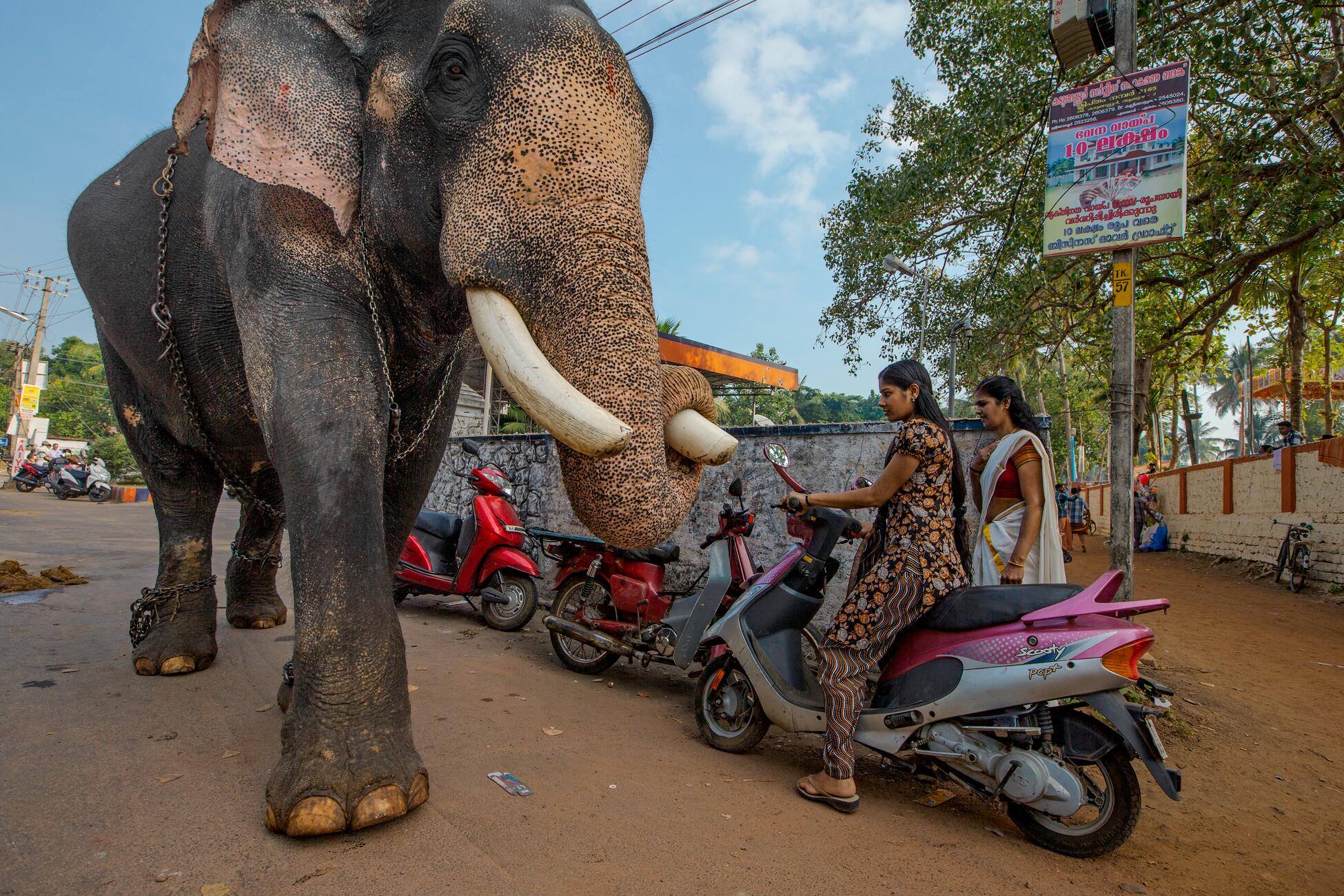
An elephant towers over two women on its way to a festival in Kerala, India. These gatherings can be traumatic and painful for elephants if they’re chained, mistreated, and forced to perform tricks. Walking on hot roads can also harm their sensitive feet. Both elephants and people die in conflicts sparked by close interaction. Preventing such deaths motivates researchers to learn as much as they can about Asian elephants and how to coexist with them.
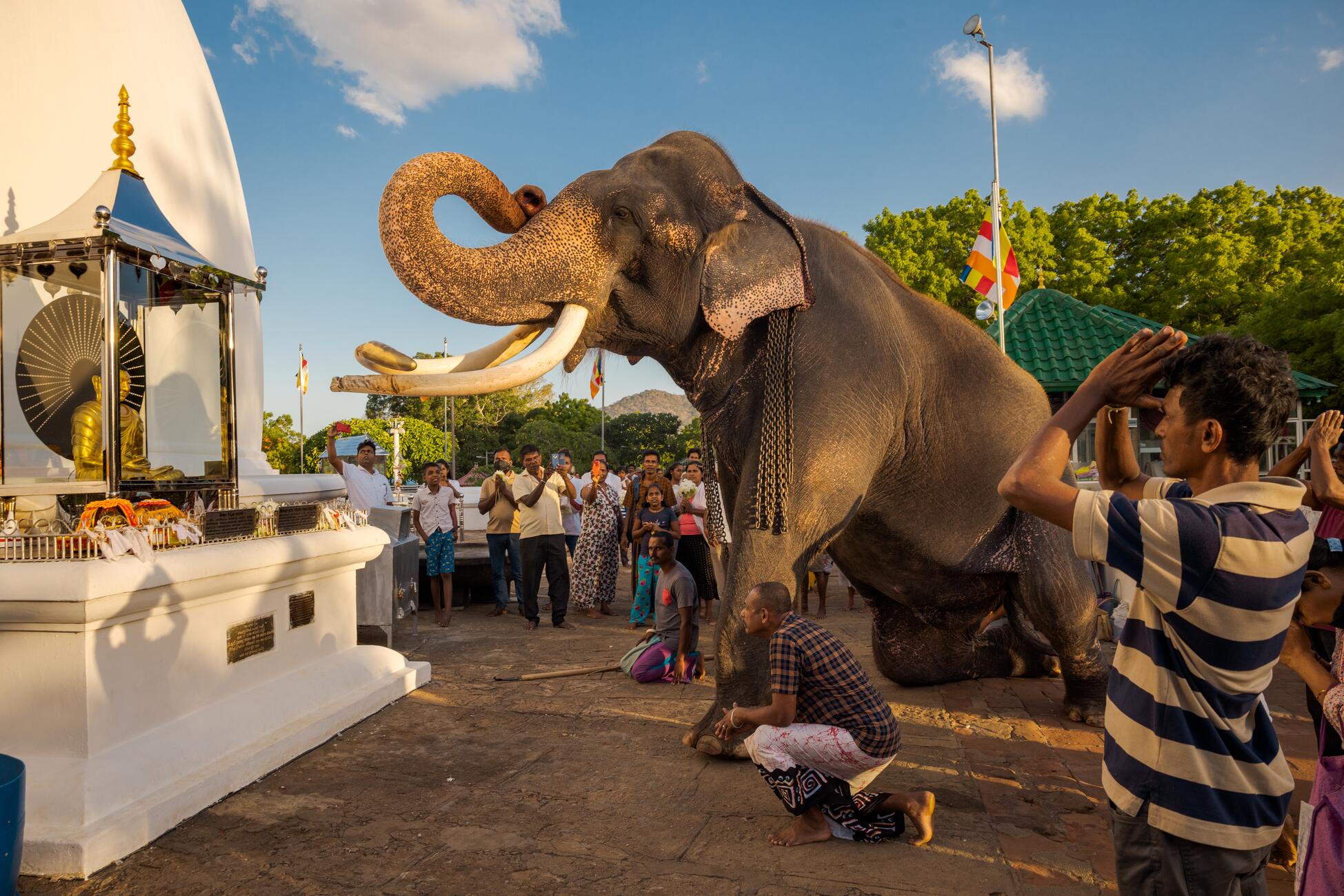
Wasana, more than 50 years old, is the temple tusker—the most prominent male elephant—at the Kataragama complex in Sri Lanka, which houses Hindu and Buddhist temples and a mosque. The animal, which was captured from the wild and handed over to the temple at age five or six, has led the Kandy Esala Perahera, the Buddhist annual procession called the Festival of the Tooth, on several occasions.
LISTEN
BEHIND THE PHOTO
However, many of these captive animals are mistreated, spending much of their lives chained in small spaces and forced to perform tricks in stressful, loud situations. In many cases, mahouts—the term for captive-elephant handlers in East Asia—trap the animals in the wild at young ages and then “break” them over years, using several forms of abuse, such as bullhooks.
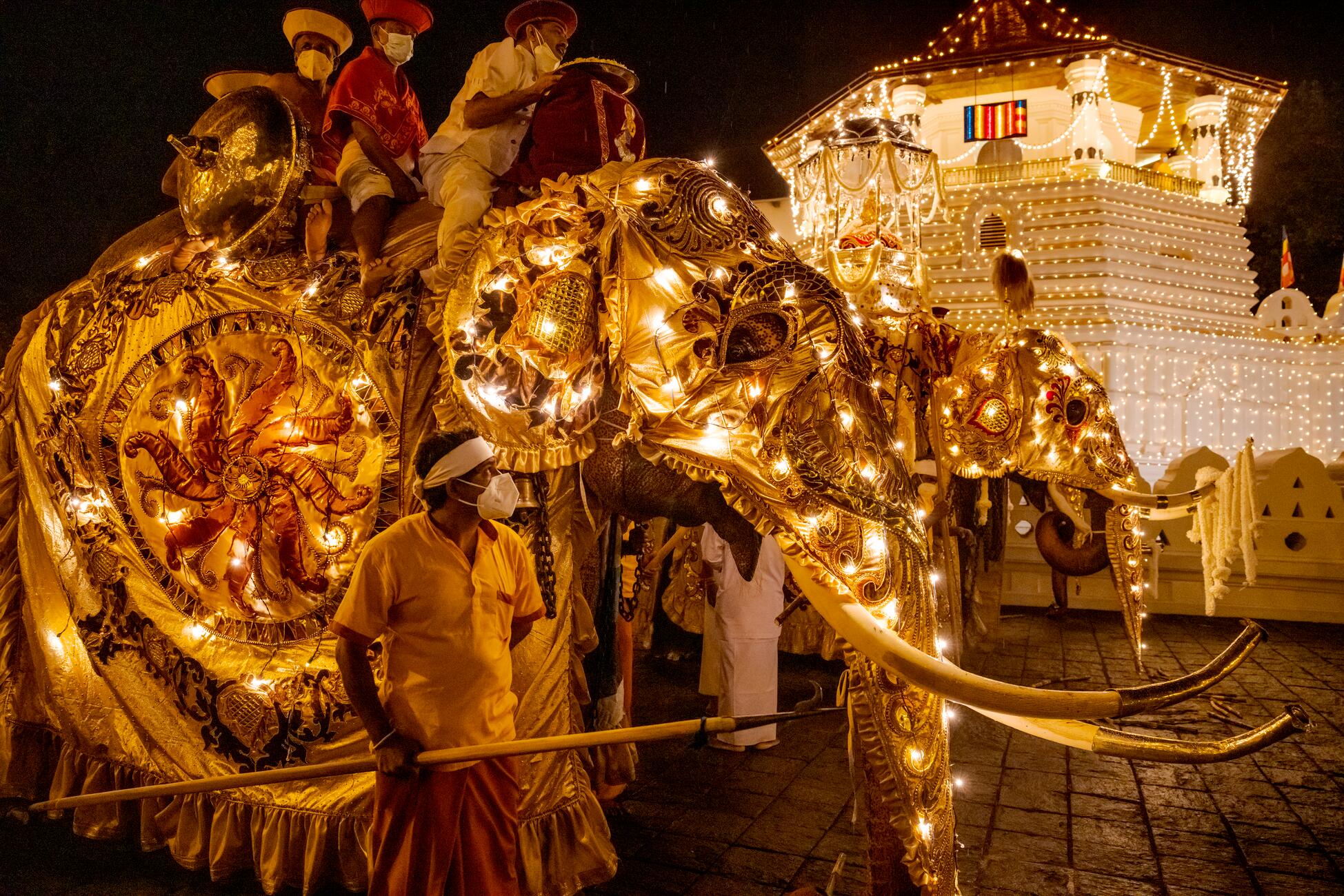
The Festival of the Tooth features about 100 elephants in ceremonial costumes. Hundreds of drummers, dancers, and singers join the parade, which began when the Buddha’s tooth was brought to Sri Lanka from India in the fourth century A.D.
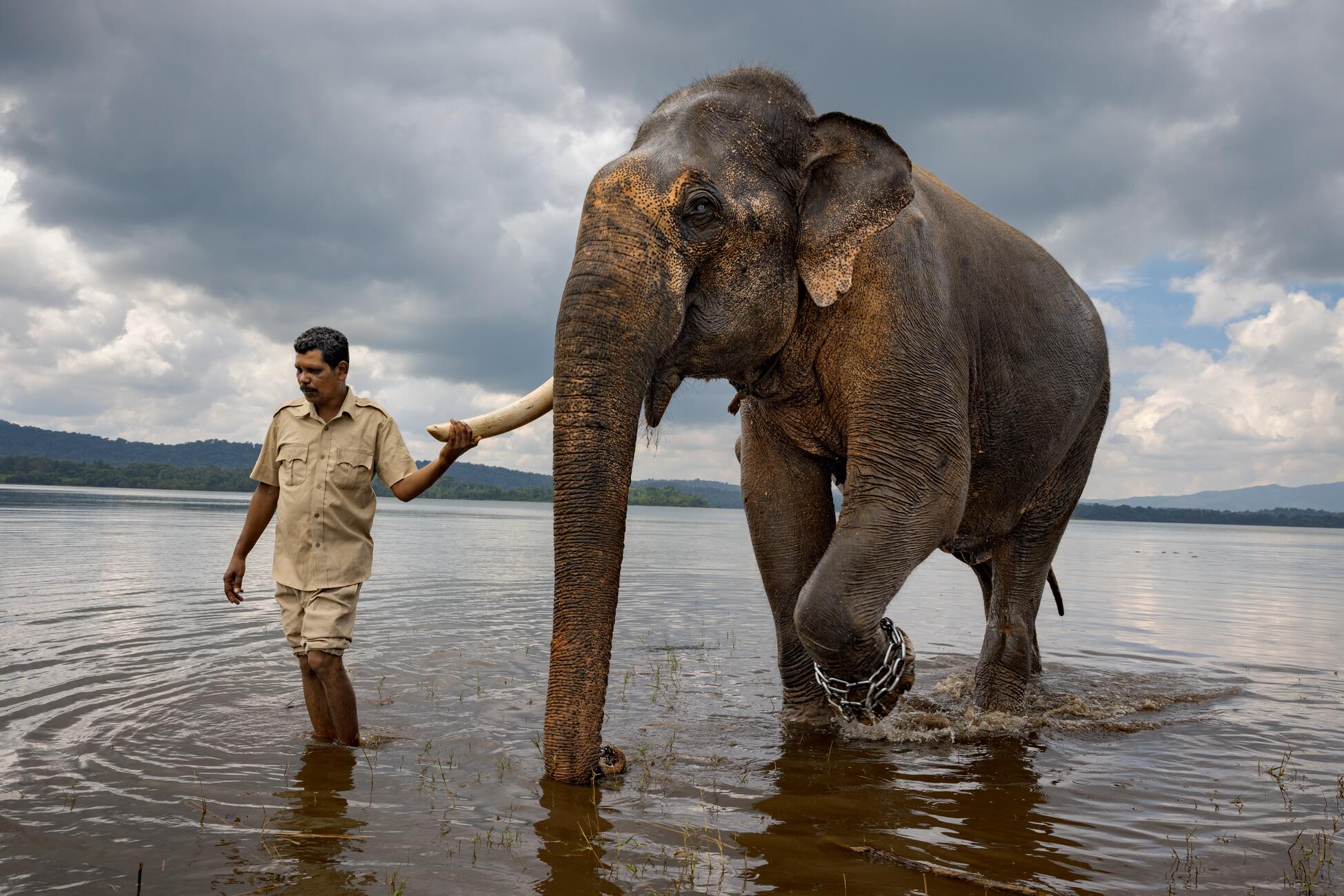
Mahout J.S. Raju leads a blind elephant, Ekadanta (Sanskrit for “single tusked”), to be bathed at Harangi Elephant Camp in Karnataka state, India. Retired from tourism, Ekadanta is likely over 60. Some researchers are turning to experienced mahouts as repositories of knowledge about elephant behavior and management.
What’s the future for the Asian elephant? Some experts believe that a mix of climatic and human-made factors will force the species into more isolated pockets. In the long run, this could lead to elephants becoming smaller, a phenomenon that has already occurred in Borneo, where elephants are 30 percent smaller than their relatives. Larger species of elephants that lived in Asia millions of years ago have already gone extinct.
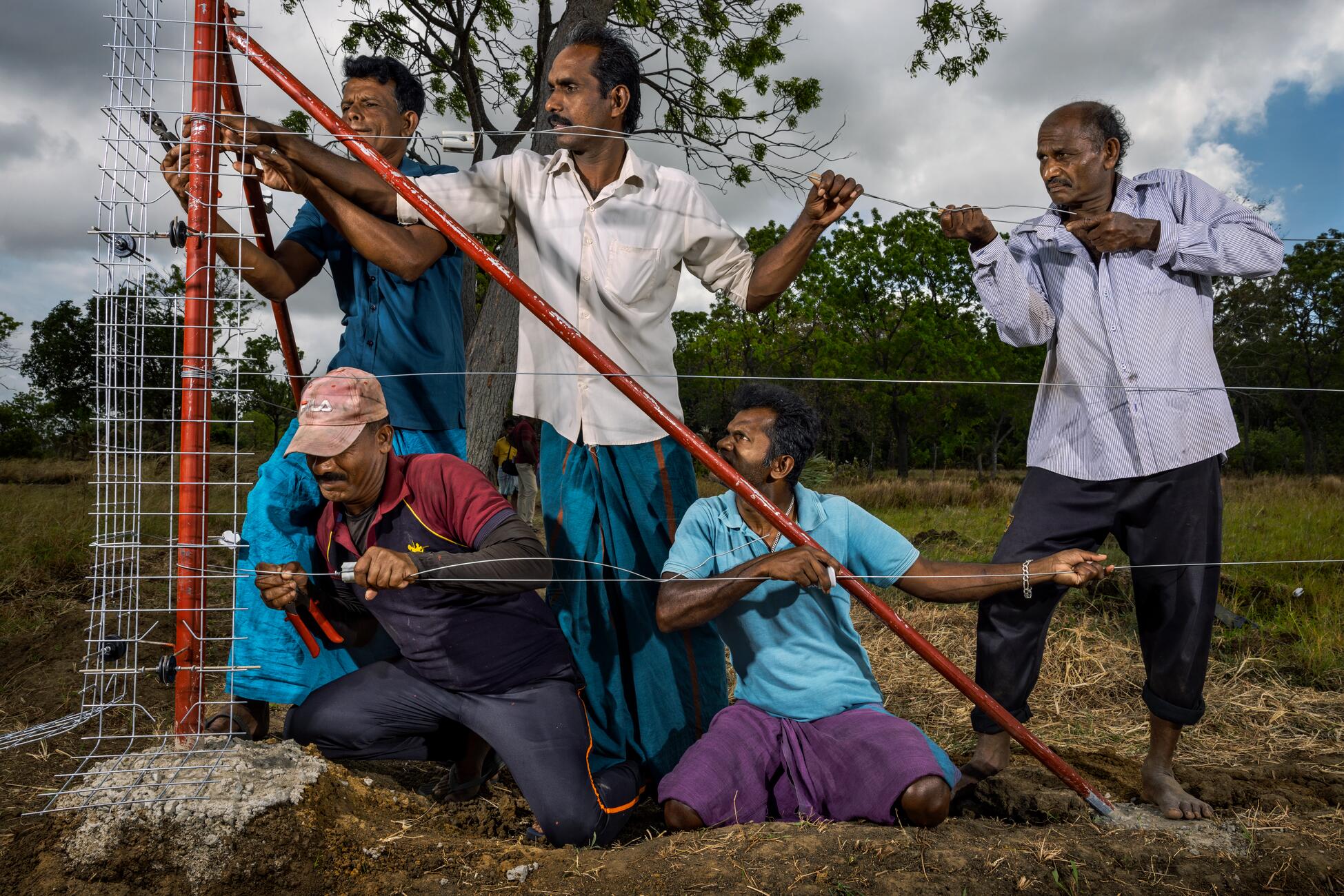
Bendiwewa villagers in Sri Lanka erect a section of solar-powered electric fencing. The 2.2-mile-long fence aims to protect 90 families’ gardens from routine elephant incursions.
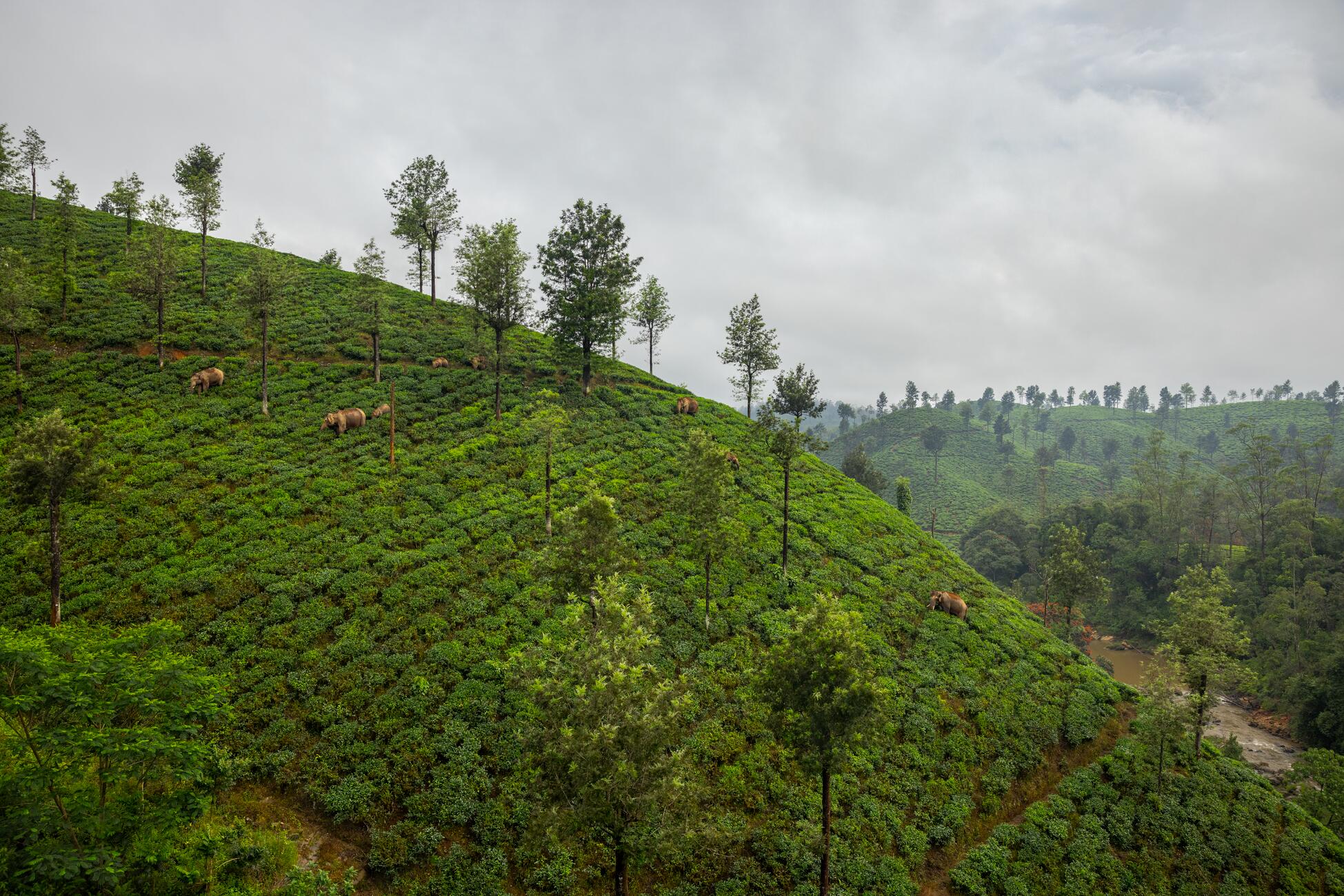
Elephants wander a tea estate in Valparai, India, which was part of their forest habitat before being converted for production in the late 1800s. Today about 70,000 people live and work in the region among 120 elephants.
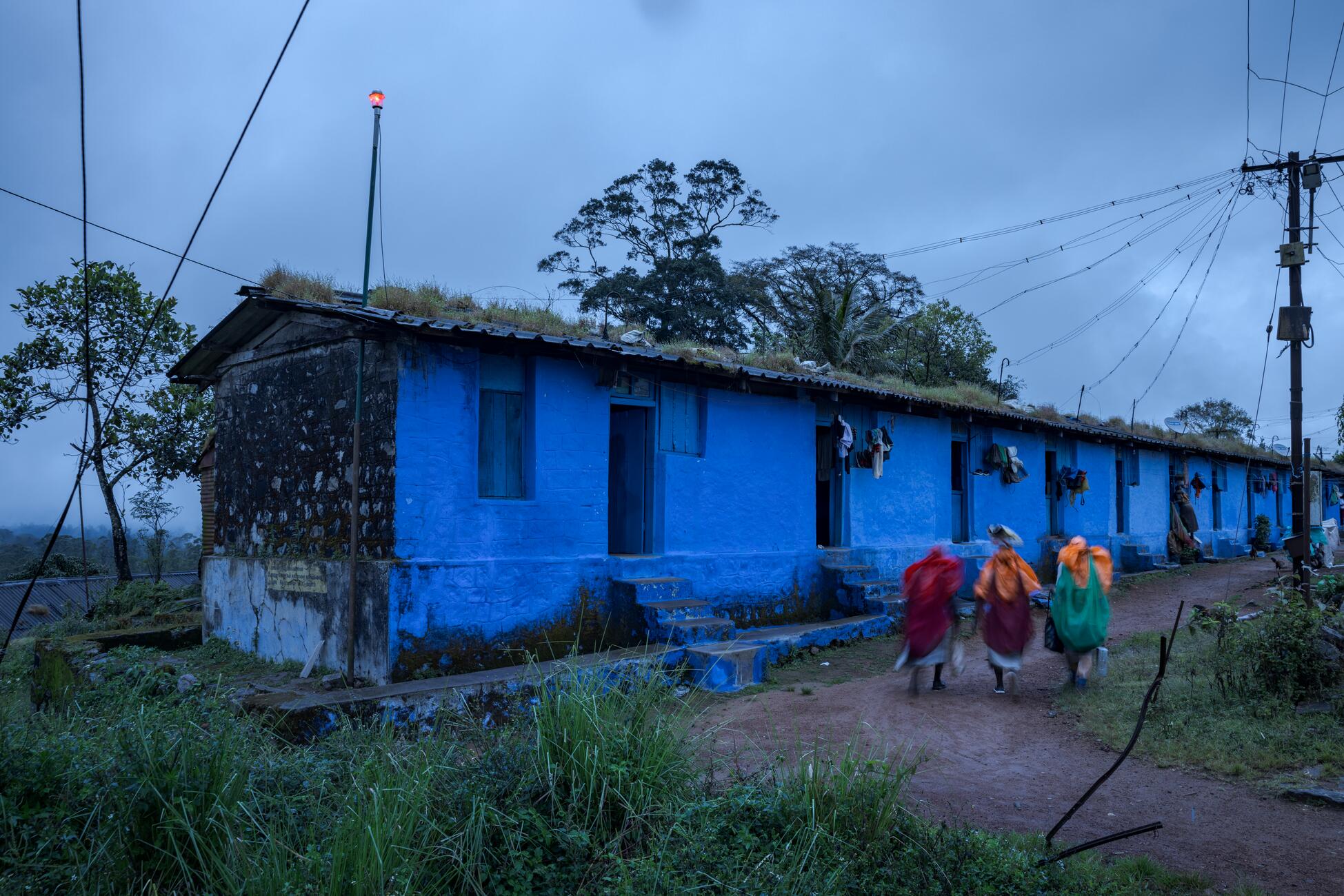
A red beacon, installed by the nonprofit Nature Conservation Foundation in Valparai, India, flashes when elephants are known to be in the vicinity. The early-warning system developed in this region, which also alerts plantation workers to an elephant’s presence via text messages and voice calls, has reduced human deaths by elephants from an average of three a year to zero in the past two years.
LISTEN
BEHIND THE PHOTO
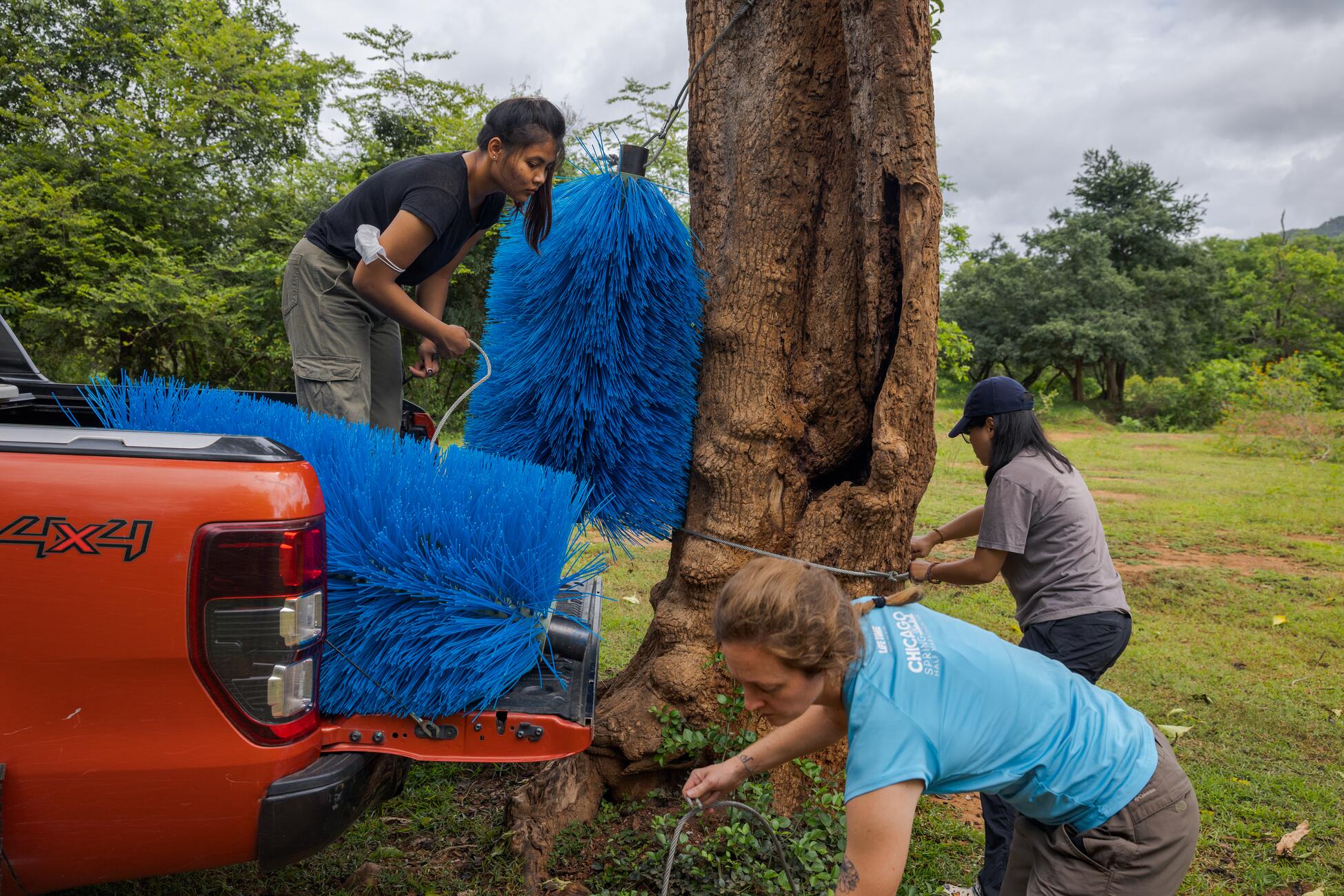
Researchers Pornpimol Kubsanit (at left), Sarah Jacobson, and Mananya Pla-ard install a novel object—a cow brush—at the edge of the Salakpra Wildlife Sanctuary in Kanchanaburi Province, Thailand. The experiment, run by Hunter College in New York City, will test wild elephants’ responses to an unfamiliar object in their habitat. Understanding more about how elephants think and behave could lessen problems between the animals and people.
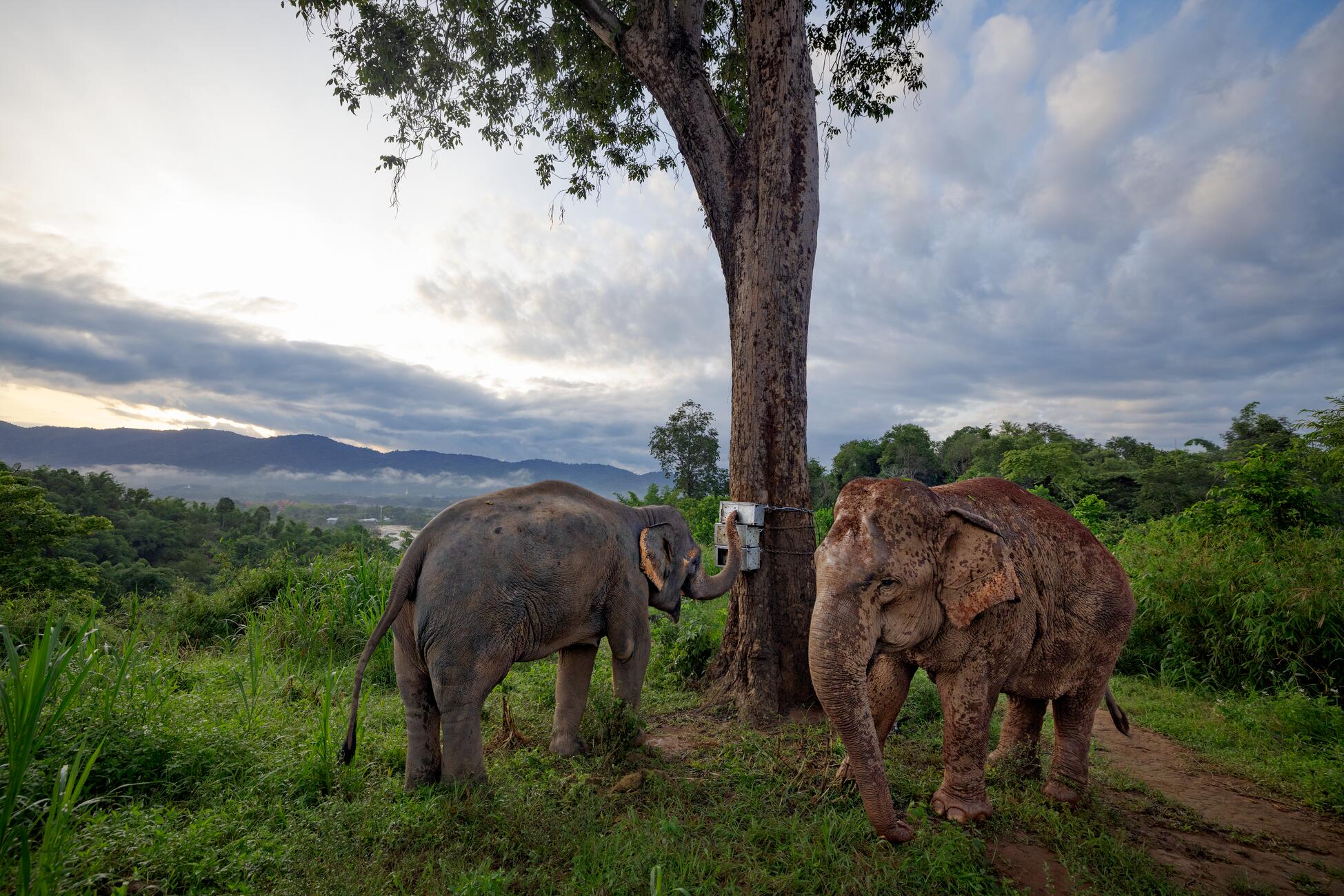
Captive elephants interact with a steel puzzle box on a hill overlooking the junction of Thailand, Laos, and Myanmar. Many wild elephants tested in a study can solve the puzzle by trying different ways to open the box’s doors, showing their ability to innovate, according to experiments by researchers at Hunter College.
LISTEN
BEHIND THE PHOTO
Yet for the time being, people’s reverence for elephants somewhat moderates the tension between the two species, says M.D. Madhusudan, an independent conservation researcher and visiting scientist at the National Centre for Biological Sciences in Bengaluru, India.
“Even where there’s a lack of physical space, there’s an enormous cultural space,” he says. That’s why, as long as elephants continue to be revered in Asia, there’s hope for their survival.

An older male elephant in Yala National Park in coastal Sri Lanka is known for taking nighttime walks on the beach. People who work with elephants often attribute distinctive personalities to them.



